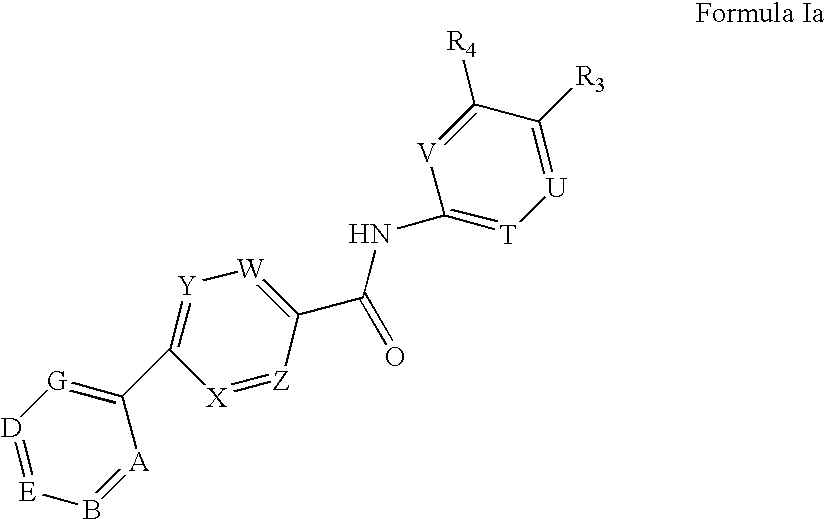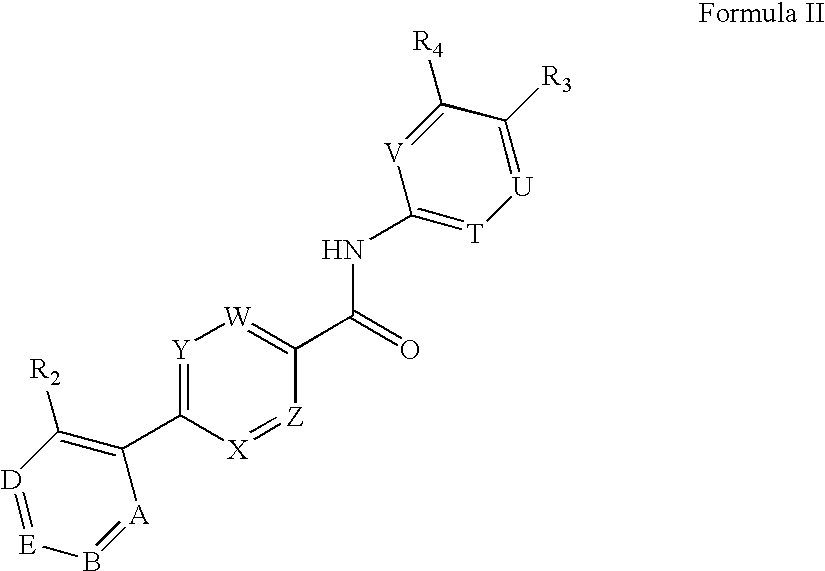Substituted biphenyl-4-carboxylic acid arylamide analogues
a technology of arylamide and biphenyl-4-carboxylic acid, which is applied in the field of substituting biphenyl-4-carboxylic acid arylamide analogues, can solve the problems of acute or chronic pain, more debilitating, and damage to the nervous system, and achieve the effects of reducing, preferably inhibiting, and stimulating the activity of capsaicin receptors
- Summary
- Abstract
- Description
- Claims
- Application Information
AI Technical Summary
Benefits of technology
Problems solved by technology
Method used
Image
Examples
example 1
Ppreparation of Representative Biphenyl-4-Carboxylic Acid Arylamide Analogues
Compound 1. 3-Hydroxy-2′-trifluoromethyl-biphenyl-4-carboxylic acid (4-tert-butyl-phenyl)-amide
1. 3-Hydroxy-2′-trifluoromnethyl-biphenyl-4-carboxylic acid methyl ester
[0252]
[0253] To a solution of 2-(trifluoromethyl)-phenylboronic acid (5.4 g, 0.03 mol), 2-(dicyclohexylphosphino)biphenyl (133 mg, 0.38 mmol), and potassium phosphate (8.1 g, 0.038 mmol) in toluene, add palladium (II) acetate (43 mg, 0.190 mmol). Purge the reaction mixture for 10 minutes with dry nitrogen and then add 4-chloro-2-hydroxybenzoic acid methyl ester. Heat the stirring reaction mixture overnight at 80° C., cool the mixture and filter through celite using ethyl acetate. Concentrate under reduced pressure, take up in fresh ethyl acetate and wash the solution with NaHCO3 (saturated aqueous). Dry the solution (Na2SO4), concentrate under reduced pressure and then filter through a pad of silica gel using ethyl acetate as eluent. Remova...
example 2
Preparation of Additional Biphenyl-4-Carboxylic Acid Arylamide Analogues
Compound 6. N-(4-tert-Butyl-phenyl)-4-(3-methanesulfonylamino-pyridin-2-yl)-benzamide
1. 4-Borono-N-(4-tert-Butyl-phenyl)-benzamide
[0288]
[0289] Heat a solution of 4-carboxyphenylboronic acid (5.0 g, 30.1 mmol), 4-t-butyl-aniline (4.5 g, 30.1 mmol), BOP reagent (13.3 g, 30.1 mmol) and triethylamine (30.1 mmol) in DMF at 80° C. for 12 hours. Cool, dilute with water, and collect the precipitate. Wash with water and hexanes to give 4-borono-N-(4-tert-butyl-phenyl)-benzamide as a solid.
2. N-(4-tert-Butyl-phenyl)-4-(3-nitro-pyridin-2-yl)-benzamide
[0290]
[0291] Bubble nitrogen through a solution of 4-borono-N-(4-tert-butyl-phenyl)-benzamide (1.3 g, 4.37 mmol), 2-bromo-3-nitro-pyridine (0.63 g, 3.12 mmol), 2M Na2CO3 (3.9 ml, 2.5 equivalents), in DME for 10 minutes. Add Pd(PPh3)4 (144 mg) and bubble nitrogen through the solution for two additional minutes. Heat the reaction for 12 hours at 80° C. Cool the reaction, co...
example 3
Additional Representative Biphenyl-4-Carboxylic Acid Arylamide Analogues
[0304] Those having skill in the art will recognize that the starting materials may be varied and additional steps employed to produce other compounds encompassed by the present invention. Compounds listed in Table I were prepared using the above methods, with readily apparent modifications. In the column labeled Ki, * indicates that the Ki determined as described in Example 5, herein, is 1 micromolar or less.
[0305] Mass spectroscopy data shown in Table I is Electrospray MS, obtained in positive ion mode with a 15V or 30V cone voltage, using a Micromass Time-of-Flight LCT, equipped with a Waters 600 pump, Waters 996 photodiode array detector, Gilson 215 autosampler, and a Gilson 841 microinjector. MassLynx (Advanced Chemistry Development, Inc; Toronto, 5 Canada) version 4.0 software was used for data collection and analysis. Sample volume of 1 microliter was injected onto a 50×4.6 mm Chromolith SpeedROD C18 co...
PUM
| Property | Measurement | Unit |
|---|---|---|
| temperatures | aaaaa | aaaaa |
| time | aaaaa | aaaaa |
| flow rate | aaaaa | aaaaa |
Abstract
Description
Claims
Application Information
 Login to View More
Login to View More - R&D
- Intellectual Property
- Life Sciences
- Materials
- Tech Scout
- Unparalleled Data Quality
- Higher Quality Content
- 60% Fewer Hallucinations
Browse by: Latest US Patents, China's latest patents, Technical Efficacy Thesaurus, Application Domain, Technology Topic, Popular Technical Reports.
© 2025 PatSnap. All rights reserved.Legal|Privacy policy|Modern Slavery Act Transparency Statement|Sitemap|About US| Contact US: help@patsnap.com



